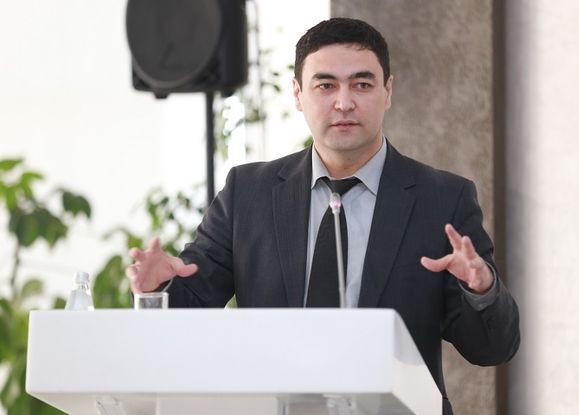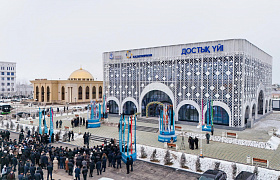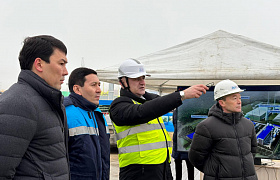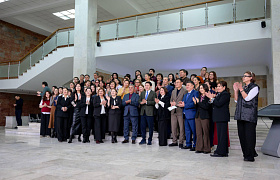Ulan Tazhibayev: "Samruk-Kazyna Fund overgrown with myths"

532
09 March 2017
Mr. Ulan Tazhibayev, Managing Director for Human Resources Management and Communications, Member of the Management Board of Samruk-Kazyna JSC talked about how the Fund manages its subsidiaries, why he believes in transformation and why stereotypes formed over a decade are misleading.
— Mr. Tazhibayev, the society has a certain perception about Samruk-Kazyna Fund. We must admit that only a few of them are positive. We would like to take a detailed look at them with you and distinguish facts from myths. First, there is an opinion that the Fund and its major subsidiaries interfere with the development of private sector. Is it true? What is the Fund’s share in the national economy?
— This thesis is often used. In my opinion, its logic is too straightforward for a correct assessment of the Fund’s impact on development of private business. Why? Because this thesis is based on an erroneous calculation that 40% of the country’s GDP is supposedly formed by the Fund. Many are accustomed to this idea and do not even questioning it. Nevertheless, it is not true. The fact is that this myth is based on a comparison of the value of the Fund's assets to GDP. The assets are like “reserves”, accumulated over the period of the Fund’s existence, and the GDP is a kind of an annual “output”. It is like comparing the cost of one machine in the production department with the plant’s annual product value. Moreover, if the machine stood on a massive concrete column, made 20 years ago, its book value would also be included in this calculation.
For comparison with GDP, it is necessary to take into account such indicators as the consolidated gross value added or the consolidated revenue of the Fund. For example, the consolidated revenues to GDP ratio provides us with the correct figure: 7.5-9%, regardless of the calculation period. The indicator will show a comparable figures for the quarter results, and for the results of the half-year, and for the year. Thus, the Fund's contribution to the creation of the total volume of national production is about 7.5-9%. Other quasi-public companies, such as Baiterek, Kazagro, as well as the public sector and, of course, private business, generate the rest. In general, following the results of 2015, the share of the whole state in the economy of the country was 19.1%. Everything else is private business.
Our, as you defined them, 'mega-subsidiaries' — KazMunayGaz and KTZ — these are big indeed. However, we cannot call them dominants in the market. For example, KMG accounts for about 28% of the total oil production in the country. KTZ owns 35% of the entire fleet of freight cars in Kazakhstan.
The Fund did concentrate large companies in certain sectors, most of which were created during the Soviet era, but the fact that it represents the greater part of the economy is a myth.
Moreover, we create conditions for the development of small and medium-sized businesses. After all, we are big responsible customers, 75% of the Group's purchases are from domestic market. We take up the capital-intensive projects, but they are necessary for the country and business. For example, our projects for the production of polypropylene, polyethylene, butadiene worth $9.6 bn will open up new opportunities for private business. Entrepreneurs will be able to generate new products based on our products.
— Right, but in addition there is an opinion that the Fund interferes with its subsidiaries by intervening in their activities. How does the Fund really build relationships with them? There must be a corporate governance principles in place, right?
— More than that — they say that companies would work independently the same way as now, except without the Fund that, in their opinion, serves as an unnecessary layer between the state and the companies. Meanwhile, in reality, the purpose of the Fund's creation is to help companies increase their value, move from social to commercial direction, raise their investment attractiveness. How can it do it? First, through the introduction of reliable standards for transparency in financial activities, risk management, management of personnel systems and, as you correctly noted, corporate governance. In addition, as part of its responsibilities towards the state, the Fund annually presents ambitious expectations to the companies in terms of productivity: operational efficiency, transparency, profitability, increment in value. This is a normal practice of shareholder behavior. How to achieve the set tasks is a matter of a qualified board of directors and management.
More specifically, the Fund's "pressure" on companies in the current period is concentrated on the following. The first is achieving positive dynamics of growth in value, even despite external factors. Of course, this can be hampered by an objective market situation - prices, changes in market conditions and others. Which actually is happening in the last few years. In this case, an effective company must quickly adapt, by cutting costs, increasing the efficiency of its processes, switching to other segments of the market. A vivid example of such work are Kazakhtelecom and Kazpost.
Secondly, the assets of the Fund should ensure the planned level of return on investment. This task does not allow investing companies' funds in projects that destroy value. The third is the implementation of all plans for cost reduction, asset optimization and privatization. And the fourth — adherence to the principles of corporate governance, the introduction of transparent HR policy mechanisms, raising the level of social stability.
In addition, there are special expectations, such as the implementation of the "Job matching" project, when we require a relevant description of the requirements for all positions and a qualified assessment of the compliance of employees with these requirements, including top positions.
These and other similar expectations, the results of which we measure and evaluate annually, are a point of tension between the Fund and companies. We can say that this is a natural process, consistent with international practice. But there is no other way to achieve efficiency.
With all this in mind, I can unambiguously answer your question - the Fund only "hinders" those who are hampered by these standards and requirements, to whom it seems that the situational management of the company by specific managers is more effective than systematic approaches.
Funds for the management of public assets is a common international practice. There are more than a hundred of them in the world. They are all different. But they all face the same task - increasing the value of state assets. The funds have proved their effectiveness in practice. The best among them are the Singapore Temasek, the Malaysian Khazanah and the Arab Mubadala.
Samruk-Kazyna is specifically aimed at increasing the value of its "subsidiaries". This is the most important criterion of effectiveness. The value of net asset of the Fund between 2008-2011 amounted to 3.1-3.5 tn KZT and for the last 5 years reached 6 tn KZT. These figures are cleared of budget contributions to the authorized capital after 2008, revenues from concessional financing and exchange rate differences after the 2015 devaluation. Thus, the indicator increased by 1.7 times. This is a good dynamic. For example, the indicator of the net asset value of Khazanah increased 1.45 times from 2010, while Temasek increased by 1.25 since 2011. Samruk-Kazyna managed to achieve such dynamics through a number of initiatives, which we described in detail earlier - the centralization of treasury functions, a program to reduce costs, automation of procurement and so on.
But we went further in achieving the task of increasing the value of the assets entrusted to us. We assume the role of an active investor, introduce a portfolio approach to the management of investment projects in the group of companies. This will allow the optimal allocation of resources.
After all, we can not interfere with the operations of our subsidiaries, simply because the corporate governance code does not allow us to do so.
— How would you describe the Fund as a taxpayer? What are its deductions to the budget?
— Since 2012, the Fund has increased the state budget revenues by 3.5 trillion tenge. When compared with the total amount of raised funds from the national budget and the National Fund for the implementation of low-profit infrastructure projects for this period, it is 1.6 trillion tenge higher. The figures speak for themselves and I suppose that questions should not arise here.
— The Fund constantly declares its desire to get rid of non-core assets. However, accusations are heard that privatization is reluctant. How can you comment the course of privatization?
— The Fund is interested in privatization. For us, it is a business necessity. Companies have many assets that do not fit into our new development strategy. We implement the program in accordance with the plan: in 2016, more than 120 small and medium-sized companies were withdrawn from the Fund's Group. The proceeds from privatization amounted to KZT 17.2 bn.
Currently, there are a number of deals at the stage of completion, such as "Locomotive Kurastru Zauyty", "Mangistau Electricity Distribution Network Company", "East Kazakhstan Regional Power Company", "Aktobe Thermal Power Plant", "KMG International N.V."
In the first half of this year, the Fund puts up for sale 12 major assets. In 2017, we plan to sell more than 20 large companies. Five of them have already attracted some overseas investors like General Electric, Talgo, Alstom, DP World and others.
— Mr. Tazhibayev, many people are skeptical about transformation. Do you really believe in it?
— I do. It is impossible to move forward without faith. The transformation is our new platform to move forward. And the most important thing in the changes is to bring maximum benefit to our society. This is what distinguishes great companies from good ones.
We also strive for this. We will become an investment holding, our projects should be oriented towards achieving commercial efficiency and utility for the country's economy. To achieve this, we are getting things in order inside. We reconsidered about 30 thousand business processes, reduced the management levels of companies down to 7, from the previous 9 levels, and we are confidently moving towards having 4-5 levels. We created 14 standards of corporate functions for our subsidiaries, in areas such as accounting and tax accounting, treasury, human resources management, information security, operational planning, risk management and so on. Finally, we started to automate the updated business processes.
Along with this, we are continuing to work on the introduction of innovative solutions in production. For example, we will be able to increase uranium production in Kazatomprom through "Digital Mine" and "Integrated Planning System" projects. The effect of these initiatives alone is estimated at KZT 20.8 bn until 2021.
We are proud of Kazpost. It really did a transformational breakthrough. It has opened a network of parcel 'supermarkets', actively works in the rural areas, offering various services, including the sale of rail and air tickets to villagers. We expect the same good results from other portfolio companies. Subsidiaries are aware about our expectations. They are spelled out in the road maps of the transformation. This clarity will exclude misunderstanding and irresponsibility. In my opinion, we managed to overcome the period of sabotage of changes. Now we all work as one big well-coordinated team to achieve goals that are understandable to us.
— Mr. Tazhibayev, the society has a certain perception about Samruk-Kazyna Fund. We must admit that only a few of them are positive. We would like to take a detailed look at them with you and distinguish facts from myths. First, there is an opinion that the Fund and its major subsidiaries interfere with the development of private sector. Is it true? What is the Fund’s share in the national economy?
— This thesis is often used. In my opinion, its logic is too straightforward for a correct assessment of the Fund’s impact on development of private business. Why? Because this thesis is based on an erroneous calculation that 40% of the country’s GDP is supposedly formed by the Fund. Many are accustomed to this idea and do not even questioning it. Nevertheless, it is not true. The fact is that this myth is based on a comparison of the value of the Fund's assets to GDP. The assets are like “reserves”, accumulated over the period of the Fund’s existence, and the GDP is a kind of an annual “output”. It is like comparing the cost of one machine in the production department with the plant’s annual product value. Moreover, if the machine stood on a massive concrete column, made 20 years ago, its book value would also be included in this calculation.
For comparison with GDP, it is necessary to take into account such indicators as the consolidated gross value added or the consolidated revenue of the Fund. For example, the consolidated revenues to GDP ratio provides us with the correct figure: 7.5-9%, regardless of the calculation period. The indicator will show a comparable figures for the quarter results, and for the results of the half-year, and for the year. Thus, the Fund's contribution to the creation of the total volume of national production is about 7.5-9%. Other quasi-public companies, such as Baiterek, Kazagro, as well as the public sector and, of course, private business, generate the rest. In general, following the results of 2015, the share of the whole state in the economy of the country was 19.1%. Everything else is private business.
Our, as you defined them, 'mega-subsidiaries' — KazMunayGaz and KTZ — these are big indeed. However, we cannot call them dominants in the market. For example, KMG accounts for about 28% of the total oil production in the country. KTZ owns 35% of the entire fleet of freight cars in Kazakhstan.
The Fund did concentrate large companies in certain sectors, most of which were created during the Soviet era, but the fact that it represents the greater part of the economy is a myth.
Moreover, we create conditions for the development of small and medium-sized businesses. After all, we are big responsible customers, 75% of the Group's purchases are from domestic market. We take up the capital-intensive projects, but they are necessary for the country and business. For example, our projects for the production of polypropylene, polyethylene, butadiene worth $9.6 bn will open up new opportunities for private business. Entrepreneurs will be able to generate new products based on our products.
— Right, but in addition there is an opinion that the Fund interferes with its subsidiaries by intervening in their activities. How does the Fund really build relationships with them? There must be a corporate governance principles in place, right?
— More than that — they say that companies would work independently the same way as now, except without the Fund that, in their opinion, serves as an unnecessary layer between the state and the companies. Meanwhile, in reality, the purpose of the Fund's creation is to help companies increase their value, move from social to commercial direction, raise their investment attractiveness. How can it do it? First, through the introduction of reliable standards for transparency in financial activities, risk management, management of personnel systems and, as you correctly noted, corporate governance. In addition, as part of its responsibilities towards the state, the Fund annually presents ambitious expectations to the companies in terms of productivity: operational efficiency, transparency, profitability, increment in value. This is a normal practice of shareholder behavior. How to achieve the set tasks is a matter of a qualified board of directors and management.
More specifically, the Fund's "pressure" on companies in the current period is concentrated on the following. The first is achieving positive dynamics of growth in value, even despite external factors. Of course, this can be hampered by an objective market situation - prices, changes in market conditions and others. Which actually is happening in the last few years. In this case, an effective company must quickly adapt, by cutting costs, increasing the efficiency of its processes, switching to other segments of the market. A vivid example of such work are Kazakhtelecom and Kazpost.
Secondly, the assets of the Fund should ensure the planned level of return on investment. This task does not allow investing companies' funds in projects that destroy value. The third is the implementation of all plans for cost reduction, asset optimization and privatization. And the fourth — adherence to the principles of corporate governance, the introduction of transparent HR policy mechanisms, raising the level of social stability.
In addition, there are special expectations, such as the implementation of the "Job matching" project, when we require a relevant description of the requirements for all positions and a qualified assessment of the compliance of employees with these requirements, including top positions.
These and other similar expectations, the results of which we measure and evaluate annually, are a point of tension between the Fund and companies. We can say that this is a natural process, consistent with international practice. But there is no other way to achieve efficiency.
With all this in mind, I can unambiguously answer your question - the Fund only "hinders" those who are hampered by these standards and requirements, to whom it seems that the situational management of the company by specific managers is more effective than systematic approaches.
Funds for the management of public assets is a common international practice. There are more than a hundred of them in the world. They are all different. But they all face the same task - increasing the value of state assets. The funds have proved their effectiveness in practice. The best among them are the Singapore Temasek, the Malaysian Khazanah and the Arab Mubadala.
Samruk-Kazyna is specifically aimed at increasing the value of its "subsidiaries". This is the most important criterion of effectiveness. The value of net asset of the Fund between 2008-2011 amounted to 3.1-3.5 tn KZT and for the last 5 years reached 6 tn KZT. These figures are cleared of budget contributions to the authorized capital after 2008, revenues from concessional financing and exchange rate differences after the 2015 devaluation. Thus, the indicator increased by 1.7 times. This is a good dynamic. For example, the indicator of the net asset value of Khazanah increased 1.45 times from 2010, while Temasek increased by 1.25 since 2011. Samruk-Kazyna managed to achieve such dynamics through a number of initiatives, which we described in detail earlier - the centralization of treasury functions, a program to reduce costs, automation of procurement and so on.
But we went further in achieving the task of increasing the value of the assets entrusted to us. We assume the role of an active investor, introduce a portfolio approach to the management of investment projects in the group of companies. This will allow the optimal allocation of resources.
After all, we can not interfere with the operations of our subsidiaries, simply because the corporate governance code does not allow us to do so.
— How would you describe the Fund as a taxpayer? What are its deductions to the budget?
— Since 2012, the Fund has increased the state budget revenues by 3.5 trillion tenge. When compared with the total amount of raised funds from the national budget and the National Fund for the implementation of low-profit infrastructure projects for this period, it is 1.6 trillion tenge higher. The figures speak for themselves and I suppose that questions should not arise here.
— The Fund constantly declares its desire to get rid of non-core assets. However, accusations are heard that privatization is reluctant. How can you comment the course of privatization?
— The Fund is interested in privatization. For us, it is a business necessity. Companies have many assets that do not fit into our new development strategy. We implement the program in accordance with the plan: in 2016, more than 120 small and medium-sized companies were withdrawn from the Fund's Group. The proceeds from privatization amounted to KZT 17.2 bn.
Currently, there are a number of deals at the stage of completion, such as "Locomotive Kurastru Zauyty", "Mangistau Electricity Distribution Network Company", "East Kazakhstan Regional Power Company", "Aktobe Thermal Power Plant", "KMG International N.V."
In the first half of this year, the Fund puts up for sale 12 major assets. In 2017, we plan to sell more than 20 large companies. Five of them have already attracted some overseas investors like General Electric, Talgo, Alstom, DP World and others.
— Mr. Tazhibayev, many people are skeptical about transformation. Do you really believe in it?
— I do. It is impossible to move forward without faith. The transformation is our new platform to move forward. And the most important thing in the changes is to bring maximum benefit to our society. This is what distinguishes great companies from good ones.
We also strive for this. We will become an investment holding, our projects should be oriented towards achieving commercial efficiency and utility for the country's economy. To achieve this, we are getting things in order inside. We reconsidered about 30 thousand business processes, reduced the management levels of companies down to 7, from the previous 9 levels, and we are confidently moving towards having 4-5 levels. We created 14 standards of corporate functions for our subsidiaries, in areas such as accounting and tax accounting, treasury, human resources management, information security, operational planning, risk management and so on. Finally, we started to automate the updated business processes.
Along with this, we are continuing to work on the introduction of innovative solutions in production. For example, we will be able to increase uranium production in Kazatomprom through "Digital Mine" and "Integrated Planning System" projects. The effect of these initiatives alone is estimated at KZT 20.8 bn until 2021.
We are proud of Kazpost. It really did a transformational breakthrough. It has opened a network of parcel 'supermarkets', actively works in the rural areas, offering various services, including the sale of rail and air tickets to villagers. We expect the same good results from other portfolio companies. Subsidiaries are aware about our expectations. They are spelled out in the road maps of the transformation. This clarity will exclude misunderstanding and irresponsibility. In my opinion, we managed to overcome the period of sabotage of changes. Now we all work as one big well-coordinated team to achieve goals that are understandable to us.
Рекомендуем

{{ $t('messages.news1') }}
Bolashaq Sarayi: the Samruk-Kazyna Group to Implement Another Large-Sc...

{{ $t('messages.news1') }}
The House of Friendship on behalf of the Samruk-Kazyna Group of Compan...

{{ $t('messages.news1') }}
Nurlan Zhakupov, Chairman of the Management Board of Samruk-Kazyna, to...

{{ $t('messages.news1') }}
Samruk-Kazyna Allocates KZT 994 Million to Renovate the Abilkhan Kaste...


